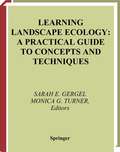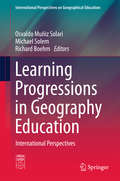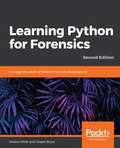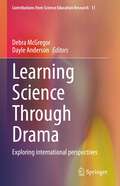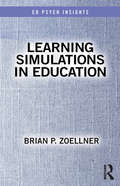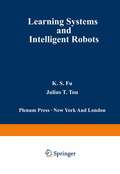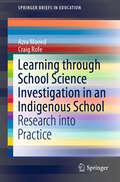- Table View
- List View
Learning in a Digitalized Age: Plugged in, Turned on, Totally Engaged? (World Class Schools Ser.)
by Lawrence BurkeAll professional learning communities agree that there is added value in utilizing technologies to enhance and facilitate student success. This volume seeks from us a critical and informed answer to one of the most important educational questions of the day: how successful will learners be in the digital age? Here, writers with real hands-on experience in the field challenge many of the assumptions about teaching and learning in the digital age. It is relevant and important for all those interested and concerned about the kinds of debates, arguments and ideas which are influencing and changing the nature of teaching and learning in the early decades of the 21st century.
Learning in Graphical Models (NATO Science Series D: #89)
by Michael I. JordanIn the past decade, a number of different research communities within the computational sciences have studied learning in networks, starting from a number of different points of view. There has been substantial progress in these different communities and surprising convergence has developed between the formalisms. The awareness of this convergence and the growing interest of researchers in understanding the essential unity of the subject underlies the current volume. Two research communities which have used graphical or network formalisms to particular advantage are the belief network community and the neural network community. Belief networks arose within computer science and statistics and were developed with an emphasis on prior knowledge and exact probabilistic calculations. Neural networks arose within electrical engineering, physics and neuroscience and have emphasised pattern recognition and systems modelling problems. This volume draws together researchers from these two communities and presents both kinds of networks as instances of a general unified graphical formalism. The book focuses on probabilistic methods for learning and inference in graphical models, algorithm analysis and design, theory and applications. Exact methods, sampling methods and variational methods are discussed in detail. Audience: A wide cross-section of computationally oriented researchers, including computer scientists, statisticians, electrical engineers, physicists and neuroscientists.
Learning in Natural and Connectionist Systems: Experiments and a Model
by R.H. PhafModern research in neural networks has led to powerful artificial learning systems, while recent work in the psychology of human memory has revealed much about how natural systems really learn, including the role of unconscious, implicit, memory processes. Regrettably, the two approaches typically ignore each other. This book, combining the approaches, should contribute to their mutual benefit. New empirical work is presented showing dissociations between implicit and explicit memory performance. Recently proposed explanations for such data lead to a new connectionist learning procedure: CALM (Categorizing and Learning Module), which can learn with or without supervision, and shows practical advantages over many existing procedures. Specific experiments are simulated by a network model (ELAN) composed of CALM modules. A working memory extension to the model is also discussed that could give it symbol manipulation abilities. The book will be of interest to memory psychologists and connectionists, as well as to cognitive scientists who in the past have tended to restrict themselves to symbolic models.
Learning in Science: The Waikato Research
by Beverley BellLearning in Science brings together accounts of the five influential and groundbreaking Learning in Science Projects, undertaken by the author over a period of twenty years. Offering comprehensive coverage of the findings and implications of the projects, the book offers insight and inspiration at all levels of science teaching and learning, from primary and secondary school science, to teacher development, and issues of classroom assessment.The book reviews the findings in the light of current science education, and is thematically organised to illuminate continuous and emerging themes and trends, including:* learning* pedagogy* assessment* Maori and science education * curriculum development as teacher development * and research methodology.Learning in Science will be a valuable resource for science teachers, science teacher educators, science education researchers, curriculum developers and policy makers.
Learning in Science: The Waikato Research
by Beverley BellLearning in Science brings together accounts of the five influential and groundbreaking Learning in Science Projects, undertaken by the author over a period of twenty years. Offering comprehensive coverage of the findings and implications of the projects, the book offers insight and inspiration at all levels of science teaching and learning, from primary and secondary school science, to teacher development, and issues of classroom assessment.The book reviews the findings in the light of current science education, and is thematically organised to illuminate continuous and emerging themes and trends, including:* learning* pedagogy* assessment* Maori and science education * curriculum development as teacher development * and research methodology.Learning in Science will be a valuable resource for science teachers, science teacher educators, science education researchers, curriculum developers and policy makers.
Learning Jupyter 5, Second Edition: Explore Interactive Computing Using Python, Java, Javascript, R, Julia, And Jupyterlab, 2nd Edition
by Dan ToomeyExplore multiple-user Jupyter Notebook servers
Learning Landscape Ecology: A Practical Guide to Concepts and Techniques
by Sarah E. Gergel Monica G. TurnerThis title meets a great demand for training in spatial analysis tools accessible to a wide audience. Landscape ecology continues to grow as an exciting discipline with much to offer for solving pressing and emerging problems in environmental science. Much of the strength of landscape ecology lies in its ability to address challenges over large areas, over spatial and temporal scales at which decision-making often occurs. As the world tackles issues related to sustainability and global change, the need for this broad perspective has only increased. Furthermore, spatial data and spatial analysis (core methods in landscape ecology) are critical for analyzing land-cover changes world-wide. While spatial dynamics have long been fundamental to terrestrial conservation strategies, land management and reserve design, mapping and spatial themes are increasingly recognized as important for ecosystem management in aquatic, coastal and marine systems.This second edition is purposefully more applied and international in its examples, approaches, perspectives and contributors. It includes new advances in quantifying landscape structure and connectivity (such as graph theory), as well as labs that incorporate the latest scientific understanding of ecosystem services, resilience, social-ecological landscapes, and even seascapes. Of course, as before, the exercises emphasize easy-to-use, widely available software.http://sarahgergel.net/lel/learning-landscape-ecology/
Learning Landscape Ecology: A Practical Guide to Concepts and Techniques
by Monica G. Turner Sarah E. GergelFilled with numerous exercises this practical guide provides a real hands-on approach to learning the essential concepts and techniques of landscape ecology. The knowledge gained enables students to usefully address landscape- level ecological and management issues. A variety of approaches are presented, including: group discussion, thought problems, written exercises, and modelling. Each exercise is categorised as to whether it is for individual, small group, or whole class study.
Learning Musculoskeletal Imaging: 100 Casi Dalla Pratica Clinica (Learning Imaging)
by Ramón Ribes Joan C. VilanovaThis is a concise introduction to musculoskeletal imaging. Each chapter includes an introduction and ten case studies with illustrations and comments from anatomical, physiopathological and radiological standpoints along with bibliographic recommendations.
Learning Progressions in Geography Education: International Perspectives (International Perspectives on Geographical Education)
by Osvaldo Muñiz Solari Michael Solem Richard BoehmThis book informs an international audience of teachers, scholars and policymakers about the development of learning progressions for primary and secondary geography education in various countries and regions of the world. The book represents an important contribution to learning progressions research and practice. The different chapters explore how curriculum standards and frameworks in different countries portray progress and sophistication in the learning of geography. The book compares educational systems and how teachers and curriculum developers use the concept of “learning progression” to guide educational practices.As an approach to educational research, learning progressions offer considerable potential for understanding how children develop understanding of geographic concepts and practices across grade bands and in relation to national geography standards. The book analyzes the general conditions of learning progressions within the context of a globalized world. Important themes are addressed such as: knowledge acquisition in formal education; measuring learning progressions in informal settings; learning progressions for one curriculum standard or several standards; conditions to assess progression in the learning of facts, concepts, and skills; and multiple pathways for understanding or learning geography. The contributing authors are experienced scientists in the field from all around the world giving specific insights into the practices of their countries.The book appeals to K-12 teachers, school administrators, policymakers, researchers in geography education, professors and lecturers at universities around the world.
Learning Python for Forensics, Second Edition: Leverage The Power Of Python In Forensic Investigations, 2nd Edition
by Preston MillerLeverage the power of Python for forensic investigations
Learning Science: The Value of Crafting Engagement in Science Environments (Innovations In Science Education And Technology Ser. #13)
by Barbara Schneider Joseph Krajcik Jari Lavonen Katariina Salmela-AroAn innovative, internationally developed system to help advance science learning and instruction for high school students This book tells the story of a $3.6 million research project funded by the National Science Foundation aimed at increasing scientific literacy and addressing global concerns of declining science engagement. Studying dozens of classrooms across the United States and Finland, this international team combines large-scale studies with intensive interviews from teachers and students to examine how to transform science education. Written for teachers, parents, policymakers, and researchers, this book offers solutions for matching science learning and instruction with newly recommended twenty-first-century standards.
Learning Science in the Schools: Research Reforming Practice
by Shawn M. Glynn Reinders DuitScience -- and the technology derived from it -- is having a dramatic impact on the quality of our personal lives and the environment around us. Science will have an even greater impact on the lives of our students. The lives of scientifically literate students will be enriched by their understanding, appreciation, and enjoyment of the natural world. To prosper in the near future, all students must become scientifically literate and embrace the notion of life-long learning in science. Without scientific literacy, it will become impossible for students to make informed decisions about the interrelated educational, scientific, and social issues that will confront them in the future. Intended for science teachers, teacher educators, researchers, and administrators, this volume is concerned with the innovative research that is reforming how science is learned in schools. The chapters provide overviews of current research and illustrate how the findings of this research are being applied in schools. This research-based knowledge is essential for effective science instruction. The contributors are leading authorities in science education and their chapters draw clear connections among research, theory, and classroom practice. They provide excellent examples from science classes in which their research has reformed practice. This book will help educators develop the scientific literacy of students. It bridges the gap between cutting-edge research and classroom practice to provide educators with the knowledge they need to foster students' scientific literacy.
Learning Science in the Schools: Research Reforming Practice
by Shawn M. Glynn Reinders DuitScience -- and the technology derived from it -- is having a dramatic impact on the quality of our personal lives and the environment around us. Science will have an even greater impact on the lives of our students. The lives of scientifically literate students will be enriched by their understanding, appreciation, and enjoyment of the natural world. To prosper in the near future, all students must become scientifically literate and embrace the notion of life-long learning in science. Without scientific literacy, it will become impossible for students to make informed decisions about the interrelated educational, scientific, and social issues that will confront them in the future. Intended for science teachers, teacher educators, researchers, and administrators, this volume is concerned with the innovative research that is reforming how science is learned in schools. The chapters provide overviews of current research and illustrate how the findings of this research are being applied in schools. This research-based knowledge is essential for effective science instruction. The contributors are leading authorities in science education and their chapters draw clear connections among research, theory, and classroom practice. They provide excellent examples from science classes in which their research has reformed practice. This book will help educators develop the scientific literacy of students. It bridges the gap between cutting-edge research and classroom practice to provide educators with the knowledge they need to foster students' scientific literacy.
Learning Science Outside the Classroom
by Martin Braund Michael ReissThis book shows how a wide range of contexts for learning science can be used outside of the classroom, and includes learning: at museums, science centres and planetaria from newspapers, magazines and through ICT at industrial sites and through science trails at zoos, farms, botanic gardens, residential centres and freshwater habitats in school grounds. With contributions from well known and respected practitioners in all fields of science education and through using case studies, Learning Science Outside the Classroom offers practical guidance for teachers, assistant teaching staff and student teachers involved in primary and secondary education. It will help enable them to widen the scientific experience and understanding of pupils. The advice in this book has been checked for safety by CLEAPSS.
Learning Science Outside the Classroom
by Martin Braund Michael ReissThis book shows how a wide range of contexts for learning science can be used outside of the classroom, and includes learning: at museums, science centres and planetaria from newspapers, magazines and through ICT at industrial sites and through science trails at zoos, farms, botanic gardens, residential centres and freshwater habitats in school grounds. With contributions from well known and respected practitioners in all fields of science education and through using case studies, Learning Science Outside the Classroom offers practical guidance for teachers, assistant teaching staff and student teachers involved in primary and secondary education. It will help enable them to widen the scientific experience and understanding of pupils. The advice in this book has been checked for safety by CLEAPSS.
Learning Science Through Drama: Exploring international perspectives (Contributions from Science Education Research #11)
by Debra McGregor Dayle AndersonThis book presents a wide range of international perspectives that explore the different ways the diverse forms of drama supports learning in science. It illustrates how learning science by adopting and adapting theatrical techniques can offer more inclusive ways for students to relate to scientific ideas and concepts. The theatrical processes by which subject matter can be introduced, thought about, discussed, transformed, enacted and disseminated are shown to be endless. The first section of the book considers different ways of theorising and applying drama in classrooms. The second section provides a range of case studies illustrating how role play, performance, embodiment and enquiry approaches can be utilised for learning in primary, secondary and tertiary education contexts. The third section demonstrates how different research methods from questionnaires, particular kinds of tests and even the theatrical conventions themselves can provide rich data that informs how drama impacts on learning science.
Learning Simulations in Education (Ed Psych Insights)
by Brian P. ZoellnerTechnology-enabled simulations are increasingly used for students in K-12 education and have the potential to improve teaching and learning across domains. Across five chapters, this book explores the psychological foundation of simulation use in instruction, guiding readers through individual differences among learners and contexts while addressing theory, pedagogy, cognitive processes, and more. This concise volume is designed for any education course that includes simulations in the curriculum and will be indispensable for student researchers and both pre- and in-service teachers alike.
Learning Simulations in Education (Ed Psych Insights)
by Brian P. ZoellnerTechnology-enabled simulations are increasingly used for students in K-12 education and have the potential to improve teaching and learning across domains. Across five chapters, this book explores the psychological foundation of simulation use in instruction, guiding readers through individual differences among learners and contexts while addressing theory, pedagogy, cognitive processes, and more. This concise volume is designed for any education course that includes simulations in the curriculum and will be indispensable for student researchers and both pre- and in-service teachers alike.
Learning Strategies
by Harold F. O'NeilLearning Strategies describes a program of research in learning strategies initiated by the Defense Advanced Research Projects Agency (DARPA) in 1976. The goal of the program is to improve learning, decrease training time, and reduce training costs by developing and evaluating instructional materials designed to teach basic intellectual and affective skills. This book records the program's progress and suggests further avenues for research. Comprised of eight chapters, this book begins with an overview of the theoretical underpinnings of the teaching and learning approaches to the improvement of education, followed by a discussion on DARPA's preliminary work on an empirically based learning-strategy training program as well as its efforts to expand and modify the program. In order to provide an intellectual foundation for this program, several fields are surveyed for potential learning strategies, namely, cognitive psychology, artificial intelligence, behavioral modification, and motor learning. An instructional systems development approach for learning strategies is also proposed. The final chapter deals with models of evaluation extant in education and training and discusses the specific application of transactional evaluation to the DARPA Learning Strategies Research Program. This monograph should be of interest to students, teachers, and educational psychologists.
Learning Strategies and Cultural Evolution during the Palaeolithic (Replacement of Neanderthals by Modern Humans Series)
by Alex Mesoudi Kenichi AokiThis volume is motivated by the desire to explain why Neanderthals were replaced by modern humans, in terms of cultural differences between the two (sub-) species. It provides up-to-date coverage on the theory of cultural evolution as is being used by anthropologists, archaeologists, biologists and psychologists to decipher hominin cultural change and diversity during the Palaeolithic. The contributing authors are directly involved in this effort and the material presented includes novel approaches and findings. Chapters explain how learning strategies in combination with social and demographic factors (e.g., population size and mobility patterns) predict cultural evolution in a world without the printing press, television or the Internet. Also addressed is the inverse problem of how learning strategies may be inferred from actual trajectories of cultural change, for example as seen in the North American Palaeolithic. Mathematics and statistics, a sometimes necessary part of theory, are explained in elementary terms where they appear, with details relegated to appendices. Full citations of the relevant literature will help the reader to further pursue any topic of interest.
Learning Systems and Intelligent Robots
by K FuThis book contains the Proceedings of the S~cond U. S. -Japan Seminar on Learning Control and Intelligent Control. The seminar, held at Gainesville, Florida, from October 22 to 26, 1973, was sponsored by the U. S. -Japan Cooperative Science Program, jointly supported by the National Science Foundation and the Japan Society for the Promotion of Science. The full texts of the twenty-one presented papers are included. The papers cover a variety of topics related to learning control and intelligent control, ranging from pattern recognition to system identification, from learning control to intelligent robots. During the past decade, there has been a considerable increase of interest in problems of machine learning, systems which exhibit learning behavior. In designing a system, if the a priori infor mation required is unknown or incompletely known, one approach is to design a system which is capable of learning the unknown infor mation during its operation. The learned information will then be used to improve the system's performance. This approach has been used in the design of pattern recognition systems, automatic control systems and system identification algorithms. If we naturally extend our goal to the design of systems which will behave more and more intelligently, learning systems research is only a preliminary step towards a general concept of integrated intelligent systems. One example of this class of systems is the intelligent robot, which integrates pattern recognition. learning and problem-solving into one intelligent system.
Learning the Physics of Einstein with Georges Lemaître: Before the Big Bang Theory
by Georges LemaîtreThis book presents the first English translation of the original French treatise “La Physique d’Einstein” written by the young Georges Lemaître in 1922, only six years after the publication of Albert Einstein’s theory of General Relativity. It includes an historical introduction and a critical edition of the original treatise in French supplemented by the author’s own later additions and corrections. Monsignor Georges Lemaître can be considered the founder of the “Big Bang Theory” and a visionary architect of modern Cosmology. The scientific community is only beginning to grasp the full extent of the legacy of this towering figure of 20th century physics. Against the best advice of the greatest names of his time, the young Lemaître was convinced, solely through the study of Einstein’s theory of General Relativity, that space and time must have had a beginning with a tremendous “Big Bang” from a “quantum primeval atom” resulting in an ever-expanding Universe with a positive cosmological constant. But how did the young Lemaître, essentially on his own, come to grips with the physics of Einstein? A year before his ordination as a diocesan priest, he submitted the audacious treatise, published in this book, that was to earn him Fellowships to study at Cambridge, MIT and Harvard, and launched him on a scientific path of ground-breaking discoveries. Almost a century after Lemaître’s seminal publications of 1927 and 1931, this highly pedagogical treatise is still of timely interest to young minds and remains of great value from a history of science perspective.
Learning Through School Science Investigation: Teachers Putting Research into Practice (SpringerBriefs in Education)
by Azra Moeed Dayle AndersonThis book explores teaching and learning through science investigation and practical work. It draws upon two representative case studies from New Zealand and examines what students are learning from science investigation; in addition, it identifies and describes ways in which teachers can make changes that benefit student learning when given time to reflect and respond to research literature and findings. The book illustrates how teaching through science investigations in ways that are informed by research can lead to positive learning outcomes for students. As such, it offers valuable insights for practitioners, researchers, and educators with an interest in learning through science investigation.
Learning Through School Science Investigation in an Indigenous School: Research into Practice (SpringerBriefs in Education)
by Azra Moeed Craig RofeThis book presents the findings of a case study conducted in a Māori medium school where a space was created for Pūtaiao (Western science) teaching and learning from year 1 to 13. Science is currently taught in Te Reo Māori in primary school and in English in secondary school, and evidence suggests that students are engaging in science education, learning to investigate, and achieving in science. In New Zealand, most students attend English medium state schools; however, approximately 15% of indegenous students attend Māori medium schools. These schools are underpinned with Kura Kaupapa Māori philosophy, which is culturally specific to Māori and aims to revitalise the Māori language, and Māori knowledge and culture. Māori students’ engagement and achievement continues to be a challenge for both mainstream and Māori medium schools, teachers and students due to lack of access to science teachers who can teach in Te Reo Māori. School leaders and whanau (families) believed that by year 9 (age 13) their students had developed their identity as Māori, and were proficient in Te Reo Māori. They wanted their students to have the option to learn science, experience success and have the choice to conitnue in science, so they made the difficult decision for science to be taught in English in secondary school. The book discusses how teachers in indigenous schools, who have extensive knowledge of culture and context specific pedagogies, can gain confidence to teach science through collaboration with and support from researchers with whom they have developed strong professional relationships.






